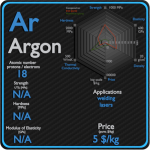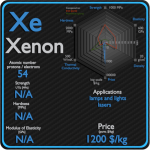This article contains comparison of key thermal and atomic properties of fluorine and neon, two comparable chemical elements from the periodic table. It also contains basic descriptions and applications of both elements. Fluorine vs Neon.

Fluorine and Neon – About Elements


Source: www.luciteria.com
Fluorine and Neon – Applications
Fluorine
Owing to the expense of refining pure fluorine, most commercial applications use fluorine compounds, with about half of mined fluorite used in steelmaking. The rest of the fluorite is converted into corrosive hydrogen fluoride en route to various organic fluorides, or into cryolite, which plays a key role in aluminium refining. Most commercial uranium enrichment processes (gaseous diffusion and the gas centrifuge method) require the uranium to be in a gaseous form, therefore the uranium oxide concentrate must be first converted to uranium hexafluoride, which is a gas at relatively low temperatures. Molecules containing a carbon–fluorine bond often have very high chemical and thermal stability; their major uses are as refrigerants, electrical insulation and cookware, the last as PTFE (Teflon).
Neon
Neon is often used in signs and produces an unmistakable bright reddish-orange light. Although tube lights with other colors are often called “neon”, they use different noble gases or varied colors of fluorescent lighting. Neon is also used to make high-voltage indicators and switching gear, lightning arresters, diving equipment and lasers. Liquid neon is an important cryogenic refrigerant. It has over 40 times more refrigerating capacity per unit volume than liquid helium, and more than 3 times that of liquid hydrogen.
Fluorine and Neon – Comparison in Table
| Element | Fluorine | Neon |
| Density | 0.0017 g/cm3 | 0.0009 g/cm3 |
| Ultimate Tensile Strength | N/A | N/A |
| Yield Strength | N/A | N/A |
| Young’s Modulus of Elasticity | N/A | N/A |
| Mohs Scale | N/A | N/A |
| Brinell Hardness | N/A | N/A |
| Vickers Hardness | N/A | N/A |
| Melting Point | -219.8 °C | -248 °C |
| Boiling Point | -188.1 °C | -248.7 °C |
| Thermal Conductivity | 0.0279 W/mK | 0.0493 W/mK |
| Thermal Expansion Coefficient | N/A | N/A |
| Specific Heat | 0.82 J/g K | 0.904 J/g K |
| Heat of Fusion | 0.2552 kJ/mol | 0.3317 kJ/mol |
| Heat of Vaporization | 3.2698 kJ/mol | 1.7326 kJ/mol |










